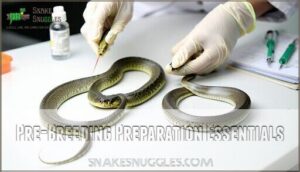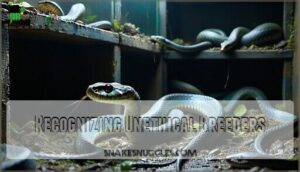This site is supported by our readers. We may earn a commission, at no cost to you, if you purchase through links.
 You’re about to venture on a snake breeding journey, and it’s vital to prioritize ethical snake breeding practices.
You’re about to venture on a snake breeding journey, and it’s vital to prioritize ethical snake breeding practices.
This means ensuring animal welfare, transparency, and responsible ownership.
You’ll want to prepare your snakes for breeding by separating sexes and stopping feeding to optimize their health.
By doing so, you’ll be well on your way to successful reproduction.
Now, let’s get into the nitty-gritty of what makes a breeder responsible and how you can make informed decisions to support ethical snake breeding practices, setting your snakes up for a healthy and thriving life.
Table Of Contents
- Key Takeaways
- Pre-Breeding Preparation Essentials
- Safe Handling and Emergency Preparedness
- Choosing a Responsible Breeder
- Recognizing Unethical Breeders
- Ethical Breeding Practices
- Snake Reproduction and Fertilization
- Captive-Bred Ball Pythons and Genetic Diversity
- Breeding Success and Post-Mating Care
- Captive Breeding and Responsible Care
- Frequently Asked Questions (FAQs)
- What are the ethics of breeding animals?
- Is it ethical to keep snakes as pets?
- Do snakes breed in captivity?
- How much money do snake breeders make?
- How do you address ethical concerns in snake breeding?
- How do I breed a snake legally?
- Can snakes self-breed?
- How do you market a snake?
- How do I prepare my snakes for breeding?
- Why is it important to breed reptiles?
- Conclusion
Key Takeaways
- You’ll want to prioritize your snakes’ well-being by separating sexes and stopping feeding to optimize their health before breeding, which is vital for their welfare and the success of your breeding program.
- To ensure ethical snake breeding, you’ll need to manage environmental factors like temperature, humidity, and photoperiod, which can trigger reproductive behaviors and impact breeding success.
- You should choose a responsible breeder who prioritizes snake welfare, transparency, and genetic diversity, and be wary of breeders who ignore your concerns or dodge questions, as they might be involved in unethical practices.
- By following responsible breeding practices, such as wise morph selection and genetic testing, you’ll help maintain genetic diversity, prevent exploitation, and support conservation efforts, ultimately ensuring the long-term viability and health of your snakes.
Pre-Breeding Preparation Essentials
You’re about to learn the essentials of pre-breeding preparation for ethical snake breeding.
Learn the essentials of pre-breeding preparation for ethical snake breeding success
By following these steps, you’ll make certain your snakes are healthy and ready for breeding, which is vital for their well-being and the success of your breeding program.
Separating Sexes and Stopping Feeding
When preparing for snake breeding, you’ll want to separate sexes and stop feeding.
Isolate males and females in individual enclosures to reduce stress and optimize health.
Then, cease feeding your snakes for two weeks prior to breeding, allowing their digestive systems to clear.
This fasting period is vital for ethical snake breeding, minimizing health complications.
By separating sexes and stopping feeding, you’ll reduce stress, optimize health, and facilitate a digestive clearout, setting your snakes up for successful pre-breeding preparation and a healthy breeding process.
Cooling Period and Temperature Control
You’re now ready to initiate the cooling period, simulating seasonal changes to trigger reproductive behaviors.
Follow these temperature control guidelines:
- Reduce daytime temperatures to 78-83°F
- Lower nighttime temperatures to 69-73°F
- Maintain for 60-90 days, ensuring proper temperature gradients for ethical snake breeding.
Many breeders also source snake cooling supplies to assist with maintaining ideal temperatures.
Humidity and Photoperiod Management
After nailing temperature control during the cooling period, let’s explore humidity and photoperiod management. These are key for good snake husbandry. You’ve got to manage these factors. This mimics nature and triggers breeding behaviors.
Here’s how to master it:
| Parameter | Recommended Range | Impact on Breeding |
|---|---|---|
| Humidity | 50-70% | Stimulates shedding success |
| Photoperiod | 10-12 hours light | Regulates hormone production |
| Temperature | 78-85°F (day) | Influences metabolic rate |
| Substrate | Moisture-retaining | Aids in humidity management |
| Ventilation | Moderate | Prevents stagnant air, respiratory health |
Precise environmental control promotes breeding triggers and the well-being of your snakes in the snake breeding environment. Humidity impact and photoperiod effects are real! Many breeders find snake humidity products helpful for maintaining proper levels.
Duration of Cooling Period
You’re now focusing on the cooling period’s length, a key aspect of snake breeding ethics.
The ideal duration typically ranges from 60-90 days.
- Simulate natural seasonal changes
- Trigger reproductive hormones
- Impact breeding success rate
- Have health implications
- Require natural simulation
For ethical snake breeding, consider the cooling period’s effect on your snakes’ health and well-being, ensuring a successful breeding season with responsible practices.
Safe Handling and Emergency Preparedness
You’re handling snakes, so prioritize safety. Keep a first aid kit with info on venom types and have sturdy enclosures with locks.
Safety first when handling snakes, prioritize their well-being and yours with proper gear and knowledge.
Use handling tools like snake hooks and know emergency prevention protocols, including Snakebite First-Aid and Enclosure Escape Protocol, to guarantee safe handling and emergency preparedness.
Essential steps also include understanding snake body language to prevent defensive reactions, which is crucial for emergency preparedness.
Choosing a Responsible Breeder
You’re about to choose a breeder, so it’s vital to prioritize the snakes’ well-being and select someone who shares your values.
By doing your research and asking the right questions, you can find a responsible breeder who treats their snakes with care and respect.
Economic Impact Analysis
You assess market demand and breeding costs to forecast profit margins, embracing ethical practices for sustainable growth.
Considering economic impact analysis and regulatory framework challenges to guarantee humane snake breeding, aligning with industry trends for promising investment opportunities and ethical certifications.
Regulatory Framework Challenges
When dealing with snake breeding regulations, you’ll find licensing and permits vary.
Be aware of state-specific laws, like Virginia’s snake protection laws.
Make certain your breeder adheres to ethical guidelines, emphasizing genetic integrity and legal compliance, amidst regulatory framework challenges and enforcement gaps in interstate commerce and morph regulations.
New breeders can benefit from educational seminars to improve their practices.
Sustainable Growth Strategies
To choose a responsible breeder, consider market demand and breeding costs to forecast profit margins.
Look for ethical certification, resource management, and a commitment to sustainable growth strategies, ensuring sustainable snake breeding practices that prioritize animal welfare and the sustainable pet trade.
Recognizing Unethical Breeders
You’ll often encounter unethical breeders who prioritize profits over snake welfare.
To recognize them, look out for:
- Overbreeding leading to health issues
- Poor facility conditions
- Health neglect
- Genetic issues
- False advertising
Be wary of breeders ignoring your concerns or dodging questions, as they might be involved in illegal practices, compromising snake breeding ethics.
Ethical snake breeding prioritizes snake welfare standards, addressing ethical concerns, and it’s crucial to support breeders who uphold snake breeder accountability, promoting responsible and humane snake breeding practices.
Ethical Breeding Practices
You’re about to learn what it takes to breed snakes ethically, prioritizing their well-being and welfare throughout the process.
By following responsible breeding practices, you’ll help maintain genetic diversity, prevent exploitation, and support conservation efforts.
All while ensuring the health and happiness of your snakes.
Responsible Morph Selection and Genetic Testing
You prioritize morph health, considering genetic diversity impact and hybridization consequences, to prevent wobble syndrome through responsible morph selection and genetic testing, ensuring ethical considerations.
You can use snake DNA testing to verify lineage and identify potential health issues.
| Morph | Health Risks |
|---|---|
| Albino | Vision loss |
| Lavender | Skin issues |
| Ultramel | Scale problems |
Transparency About Genetic Risks
You build trust by disclosing genetic risks.
Share results of genetic testing, inbreeding risks, and health issues in F1 offspring, including:
- Genetic defect disclosure
- Inbreeding consequences
- Hybridization dangers
- Morph-related issues, ensuring lineage transparency in ethical snake breeding.
Captive-bred snakes often exhibit more docile temperaments, which is a result of careful breeding practices.
Respecting Nature’s Brilliance and Responsible Ownership
You’re embracing ethical snake breeding by respecting nature’s brilliance.
This involves conservation efforts, ethical sourcing, and habitat preservation.
As a responsible owner, you prioritize snake welfare, supporting public education on ecological impact and promoting responsible ownership, which is key to ethical snake breeding considerations.
Snake Reproduction and Fertilization
You’re about to learn how snakes reproduce and fertilize, a vital aspect of ethical snake breeding practices.
As you read on, you’ll discover the fascinating processes of pheromone stimulation, reproductive behavior, and unique mating rituals that occur in different species.
Pheromone and Pheromorpheromne
Delving into pheromone signaling reveals the secret language of snakes. Pheromones, the invisible messengers, create pheromone trails, guiding snake attraction and reproductive behavior.
In your breeding program, you’ll want to take into account:
- Ensuring controlled environments.
- Monitoring chemical communication carefully.
- Understanding snake communication intricacies.
- Facilitating natural snake courtship behaviors.
- Identifying breeding triggers and reproductive cues.
Maximizing snake reproduction success requires understanding the breeding process and pheromones. We can introduce male ball pythons to females when temperatures drop after the N.A.R.B.C. Tinley show.
Reproductive Behavior Stimulation
You stimulate reproductive behavior in snakes by creating a perfect environment.
Cooling triggers and mating cues, like pheromones, influence hormonal responses.
Environmental enrichment, such as temperature and humidity adjustments, aids breeding readiness, triggering reproductive behavior stimulation and mating rituals in snake reproduction, which can be influenced by pheromones.
Unique Mating Rituals Different Species Behavior
You’ll find unique mating rituals across species.
Some snakes use:
- Courtship displays
- Species-specific dances
- Pheromone communication, showcasing reproductive strategies and mating competition in snake breeding, highlighting fascinating reproductive behavior and species behavior in snake courtship behaviors.
This showcases fascinating reproductive behavior and species behavior in snake courtship behaviors.
Captive-Bred Ball Pythons and Genetic Diversity
You’re now considering captive-bred ball pythons, where genetic diversity is essential.
Responsible breeding practices, such as wise morph selection and genetic testing, help avoid inbreeding risks and genetic bottlenecks.
This supports conservation efforts and enriches the genetic pool, minimizing morph overproduction and hybridization ethics concerns.
Understanding Punnett squares can further refine breeding predictions.
By prioritizing genetic diversity in snake breeding, you’ll guarantee the long-term viability of your ball pythons, promoting ethical practices and a positive conservation impact.
Breeding Success and Post-Mating Care
You’re aiming for breeding success. To achieve it, focus on post-mating nutrition, egg incubation, and hatchling care.
Consider:
- Monitoring egg viability
- Providing nutritious meals
- Maintaining breeding records for genetic health and breeding success.
Proper incubation techniques are necessary for high hatch rates, ensuring healthy snake reproduction and reproductive behavior.
Maintaining these practices will lead to overall healthy snake reproduction.
Captive Breeding and Responsible Care
You’re about to enter the sphere of captive breeding, where responsible care is key.
Designing habitats that mimic natural environments is vital, with ample space for movement to prevent health hazards.
Invest in suitable reptile enclosure solutions and prioritize genetic testing to maintain genetic diversity and prevent inbreeding.
Adhere to legal regulations and guarantee ethical sourcing, veterinary oversight, and habitat preservation.
For successful breeding, remember that females need to meet specific size requirements.
By doing so, you’ll contribute positively to conservation impact and guarantee the well-being of your snakes, promoting ethical snake breeding practices that prioritize snake health management and genetic diversity.
Frequently Asked Questions (FAQs)
What are the ethics of breeding animals?
You’ll face criticism, but breeding animals ethically means prioritizing their welfare, genetic diversity, and natural behaviors, ensuring their well-being and safety above personal gains or interests always.
Is it ethical to keep snakes as pets?
You can keep snakes as pets if you provide proper care, housing, and attention to their specific needs, ensuring their well-being and safety.
Do snakes breed in captivity?
You’re the conductor of a reptilian orchestra, and yes, snakes can breed in captivity with proper care, nutrition, and environment, mimicking their natural habitat to stimulate reproduction.
How much money do snake breeders make?
You can earn a significant income, but profits vary widely, depending on factors like breed, demand, and experience, with successful breeders potentially making upwards of $50,000 annually.
How do you address ethical concerns in snake breeding?
You prioritize snake welfare, genetic diversity, and responsible ownership, addressing concerns through transparent practices, proper care, and adherence to regulations, ensuring a positive breeding experience.
How do I breed a snake legally?
You’ll need to research and comply with local laws, obtain necessary permits, and guarantee proper care and housing for your snakes to breed them legally and responsibly.
Can snakes self-breed?
You’ll find that snakes typically require a mate to breed, as they don’t usually self-breed due to their reproductive biology.
How do you market a snake?
You showcase a snake’s unique features, highlighting its color, pattern, and temperament, to attract potential buyers and build a reputation as a trustworthy, knowledgeable snake breeder or seller.
How do I prepare my snakes for breeding?
You’ll separate males and females, stop feeding them for two weeks, and reduce temperatures to trigger reproductive behaviors, ensuring a healthy breeding process for your snakes.
Why is it important to breed reptiles?
You breed reptiles to preserve species, maintain genetic diversity, and support conservation efforts, ultimately ensuring the long-term viability and health of these amazing creatures.
Conclusion
You reap what you sow, so prioritize ethical snake breeding practices.
By doing so, you’ll guarantee animal welfare and transparency.
Remember, it’s all about responsible ownership and supporting ethical snake breeding practices, which sets your snakes up for a healthy life, and you’ll be rewarded with a thriving reptile community that values ethical snake breeding practices.
- https://www.news24.com/news24/search?query=ethical%20responsibilities
- https://www.blogrollcenter.com/?s=reptiles
- https://tetezonews.com/32892-the-best-habitats-for-your-pet-snakes-46/
- https://www.traffic.org/what-we-do/perspectives/captive-breeding/
- https://showmereptileshow.com/resources/starting-a-reptile-breeding-business-with-the-support-of-show-me-reptiles
















